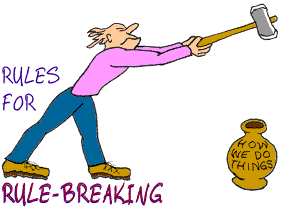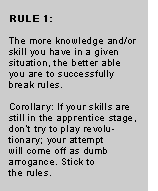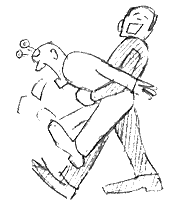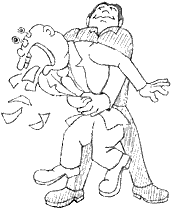 |
|
||||||||||||
|
About San
inSANity columns: The
Better You Are, When
The Bastards Ugly Brides and Other Temptations Will The Real Freaks Please Raise Their Hands? The Fine Art of Kicking Yourself |
To some people, "professional" means a deep understanding of the standards in a field, and adherence to them. To others, "professional" means almost the opposite: being so good that you can make up your own rules, and get away with it. If you're in the latter category -- or perhaps just an aspiring iconoclast -- then you should know that rule-breaking has rules of its own. Successfully smashing standards requires one or more of the following: knowledge, power, and tolerance for risk. Knowledge It's not wise to violate rules until you know how to observe them.
On the left is one of my initial rough sketches. It follows the "draw actions in profile" rule. On the right is my final pencil drawing (click on it to see the actual illustration). It breaks the rule, but has more emotional appeal -- and this despite the fact that tightly-drawn pencil "finishes" are usually less appealing than early-stage rough sketches. I had enough knowledge and skill to break the rule successfully; but years earlier, when I couldn't draw as well, I would have been better off sticking to the rule. Power A rooster has great influence on his own dunghill.
In the freelance world, the effect of power on rule-breaking is often more subtle, but it's still a factor. In one scenario, it may involve prospective clients' adherence to their own rules. In my experience, when you pitch your services to someone low in a corporation, and they can't peg you into a standard category they've set up, they often won't hire you. ("Oh, you're a computer-based illustrator, but our specification calls for a traditional illustrator.") By comparison, a powerful top exec is more likely to look at possibilities than at rules, specs, or categories. ("Say, your work is pretty good; maybe we should use you on this project somehow. Did you say you also do design?") Another scenario involves your own likelihood to break rules with an existing client, based on how much power you have in that situation -- such as your perception of how much the client needs you, and how painful it would be for them to replace you. I once freelanced for a teeny-tiny ad agency that lacked its own creative department. In fact, the agency was basically just two kids in a room, working for a parent company that was in some other (non-agency) business. I had been assuming that there were a few freelance creatives working for this ad agency, of whom I was only one. One day, one of my young clients casually mentioned that the agency subcontracted to me all the creative work it received -- that, in fact, I was the only art director and the only copywriter they knew. To her it was just an offhand remark, but I knew immediately that she had made a tactical mistake by telling me this. She had handed me more power in our relationship by revealing that it would be difficult for them to replace me. I didn't take advantage of my newfound knowledge in any major way, but I did become a little more experimental in my work for them -- in essence, breaking some conservative design "rules" and having a little more fun with the work. As it turned out, the more wild my work got the more they liked it, but I had no way of knowing this initially. The point is that it was my increased power in the relationship that gave me the freedom to break more rules. Tolerance for Risk The man who will follow precedent, but never create one, is merely
an obvious example of the routineer....What he thinks is the heavens
above him is nothing but the roof.
Designers love money-burning opportunities like this; most would have opted for safe and conventional luxury techniques such as translucent slip sheets and embossed foil-stamping. Instead, I decided to use a series of innovative and precise die-cuts (variously shaped holes cut out of the pages). The holes would be tightly integrated with my illustrations on those pages. The printing foreman, when he saw the job I'd designed, almost had a heart attack -- it was technically difficult and risky and he wanted no part of it. He went over my head (or behind my back) and told the client that I had designed a job that "couldn't be printed." Of course, the printer was just covering his butt in case the printing failed, but the client naturally went ballistic and started screaming at me on the phone. First I calmed and reassured the client. Then I spoke to the printing foreman and appealed to his professional pride, reputation, and fear of lawsuits. Then I supervised the printing very closely, as I always do. I drove the printers nuts (as usual) and the job was printed and die-cut successfully (as usual). The client was happy, I was happy, the printer was angry but proud of the result... but what was my motivation for breaking the rules in the first place? The two rules I had broken were:
Why would I risk breaking these rules? Because I knew that there would be substantial payoffs for me if the job succeeded:
Balancing the technical risks with the potential rewards, how did I make the call? Normally I'm as risk-averse and cowardly as the next guy, but confidence in my own skill made me more willing to take the risk. Perhaps it's a question of control: there are some people who get carsick unless they're driving, or are afraid of flying unless they're the pilot. In many risk areas, where I have no control, I'm a coward; but in prepress, where I'm a knowledgeable control freak, I'm much more of a risk-taker.
Knowledge, power, and tolerance for risk: being able to break rules successfully usually comes down to one or more of these. Knowledge: If you don't even know that there is a rule of thumb in a given situation, you probably don't know enough to break it safely. Power: If you know about a Rule Of Thumb and are worrying a lot about 'getting in trouble' for breaking it, then you may not have enough power to break it safely. Risk: If breaking rules just makes you nervous in general, then you're probably too risk-averse for an unconventional approach. On the other hand, if you never break any rules, then you're doomed to forever be just a follower... treating life as some kind of a franchise deal where someone else provides all the structure, and you just fit yourself into that pattern and go through the pre-ordained motions. Where's the fun in that? |
|||||||||
|
San was the founding editor of 1099 Magazine, serving as its first editor-in-chief and creative director. He's now back in the boss-free world as a freelance writer and illustrator. In addition to the inSANity column on 1099, San's other writings and cartoons are at www.sanstudio.com. We'd love to hear your feedback about this column. |
||||||||||
|
|
||||||||||
The 1099 name and logo are trademarks of 1099 Magazine.


 Even
though as a cartoonist I rarely worked on animation projects, part of
my self-training was to study the standard Disney "rules" for drawing
cartoons -- draw with appeal, don't draw 'twins,' isolate and clarify
the key action, and so forth. Another of these rules is to draw action
in profile whenever possible, rather than frontally or with characters
overlapping each other, because action is almost always clearer in profile.
For many years, I followed this rule religiously. Eventually, however,
I had cultivated enough drawing skill to recognize previously invisible
tradeoffs, such as situations where drawing an action in profile strengthened
clarity (as the rule predicted) but also weakened the emotional impact.
Once I understood this, the next step was to learn how to achieve clarity
in spite of frontal overlaps. Here's an example from the illustration
I did for 1099's
Even
though as a cartoonist I rarely worked on animation projects, part of
my self-training was to study the standard Disney "rules" for drawing
cartoons -- draw with appeal, don't draw 'twins,' isolate and clarify
the key action, and so forth. Another of these rules is to draw action
in profile whenever possible, rather than frontally or with characters
overlapping each other, because action is almost always clearer in profile.
For many years, I followed this rule religiously. Eventually, however,
I had cultivated enough drawing skill to recognize previously invisible
tradeoffs, such as situations where drawing an action in profile strengthened
clarity (as the rule predicted) but also weakened the emotional impact.
Once I understood this, the next step was to learn how to achieve clarity
in spite of frontal overlaps. Here's an example from the illustration
I did for 1099's 

 Within
the corporate world, top executives are usually a lot more casual about
their company's rules than are the people below them. The big cheeses
were often involved in making the rules in the first place, so they
know just how arbitrary, or at least ad hoc, those rules are. Also,
of course, they're less likely to get in trouble for breaking rules,
so they can afford to be more casual about them.
Within
the corporate world, top executives are usually a lot more casual about
their company's rules than are the people below them. The big cheeses
were often involved in making the rules in the first place, so they
know just how arbitrary, or at least ad hoc, those rules are. Also,
of course, they're less likely to get in trouble for breaking rules,
so they can afford to be more casual about them.
 I
once designed and art-directed a series of brochures for a company that
had lots of money to burn and wanted me to help them burn it. Unfortunately,
rather than pay me a bigger-than-normal fee with the extra cash, the
client wanted me to spend the big bucks on fancy production techniques.
I
once designed and art-directed a series of brochures for a company that
had lots of money to burn and wanted me to help them burn it. Unfortunately,
rather than pay me a bigger-than-normal fee with the extra cash, the
client wanted me to spend the big bucks on fancy production techniques.